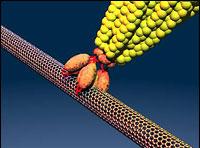
Researchers from various departments (Materials Science and Engineering, Biological and Chemical Engineering) at Massachusetts Institute of Technology (MIT) have discovered a way to produce a genetic engineered high-powered lithium ion battery using bacteriohage. The new technology can be used for future electric cars, iPods, computers or any necessary electrical equipment.
The M13 virus had two of its genes manipulated resulting in peptide groups attaching themselves to Single Walled carbon Nanotubes (SWNT). By genetic modifying the major coat protein, pVIII (p8 on the M13 virus) was fused with amorphous Iron phosphate (a-FePO4) to SWNT to form a cation hybrid. This cation hybrid performed better than regular crystalline Lithium ion iron phosphate (c-LiFeO4) cations. The anode end is made of cobalt oxide and gold to form a self-assembling nanowire.
Other advantages of this system include a low manufacturing cost and low toxic to humans or even bacteria. The research funded by the Korean Science and Engineering Foundation of the Ministry of Education, Science and Technology (MOEHRD).
Posted By: Chris LAM 41735613
Source: Belcher et al. 2009 'Fabricating genetic engineered high-powered lithium ion batteries using multiple virus genes', 2 April 2009 [viewed 17 May 2009]
DOI: 10.1126/science 1171541